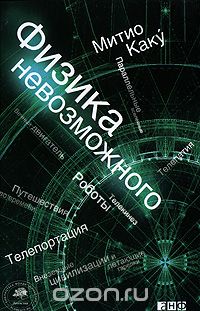The physics of the impossible: A scientific explanation of phasers, force fields, teleportation, and time travel
 Probably every reader Habra wants to get his lightsaber or talk with a representative of an alien civilization. But will it ever come true? The answer to this and other similar questions is devoted to the book "Physics of the Impossible . "
Probably every reader Habra wants to get his lightsaber or talk with a representative of an alien civilization. But will it ever come true? The answer to this and other similar questions is devoted to the book "Physics of the Impossible . "It is written by a theoretical physicist, a leading BBC popular science broadcaster and a popularizer of science, Michio Kaku , who has communicated a lot with outstanding minds of modern times. His consultants were 10 Nobel Prize winners, famous physicists, astronomers, writers and even one comic book author.
Dr. Kaku explores the cutting-edge fields of science to answer the questions that “tormented him since childhood”: Will we ever learn to walk through walls? Build starships that can fly faster than light? Read minds? Instantly overcome outer space?
More broadly, the main question of the book is “if something is“ impossible ”today, will it remain impossible even in a hundred or a million years?” About 50 years ago, the ability to communicate on a mobile phone seemed far-away fiction, and today for Us this is mundane, even slightly annoying, reality. According to the author, the purpose of his book is “to consider those technologies that today are considered impossible, but in a few tens or hundreds of years can become ordinary.”
')
In the "Physics of the impossible" 15 chapters on various issues and related technologies:
- Protective force field;
- Invisibility;
- Phasers and Death Stars ;
- Teleportation;
- Telepathy ;
- Telekinesis ;
- Robots;
- Extraterrestrial civilizations and flying saucers;
- Starships;
- Antimatter and anti-universe ;
- Faster than light;
- Time travel;
- Parallel universes;
- Perpetual motion machine;
- Anticipation of the future.
It was a surprise for me to find out that humanity is much closer to creating force fields capable of stopping bullets and missiles, such as the alien ships in the movie “Independence Day” than to artificial intelligence. Or, for example, that the invisible being, like Harry Potter, is still far away from the cloak, but scientists are likely to be able to create metamaterials that are streamlined for light rays, that is, making objects hidden behind them, literally invisible.
When considering each issue, the author shares with the reader information about theoretical research in a particular field, for example, M-theory in the chapter on parallel universes, and on real scientific developments, such as the Shiva laser fusion project in the Death Star chapter.
This approach makes the book very interesting. After reading it, on the one hand, the fundamental laws of our universe (and others too) become familiar and, on the other hand, you begin to understand the connection between theoretical, often abstract science and practical developments.
Michio Kaku follows Stephen Hawking's rule about books on physics *, therefore there is only one formula in his work. I think it is easy to guess what. In addition, the book is written in easy language using images that are understandable even to a child. Reading her is a pleasure.
“Physics of the impossible” was released with the assistance of the Dynasty Foundation . Elements.ru , created with the support of the foundation, has published fragments from it . But I recommend you read the book completely, it will be extremely interesting!
* This rule was formulated by Stephen Hawking’s book publisher. It states that every formula in the book halves the number of readers.
Source: https://habr.com/ru/post/93902/
All Articles